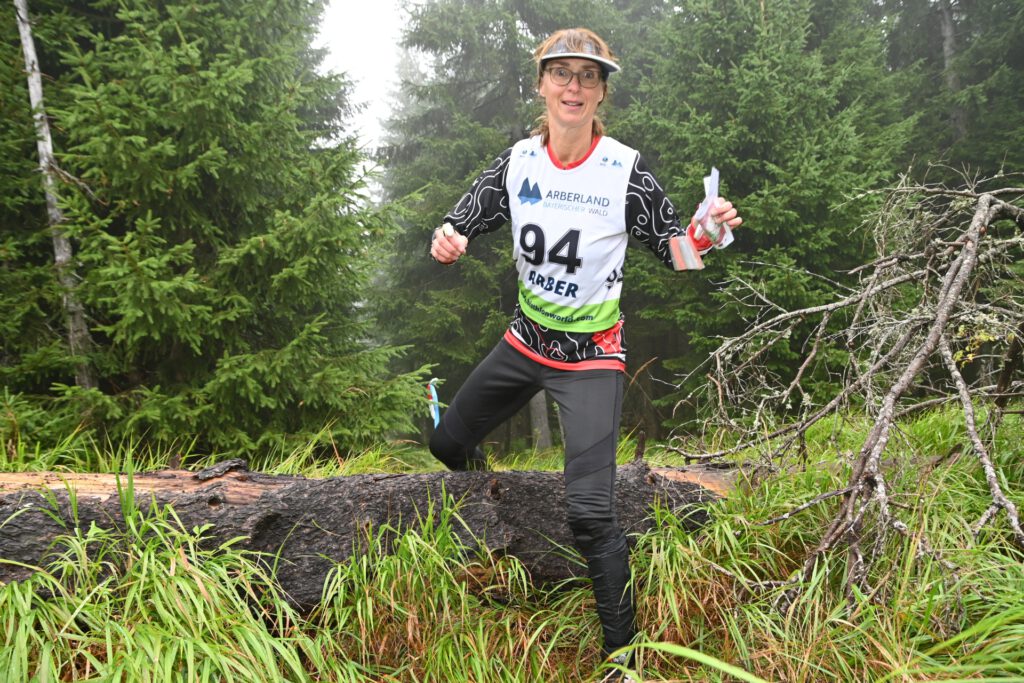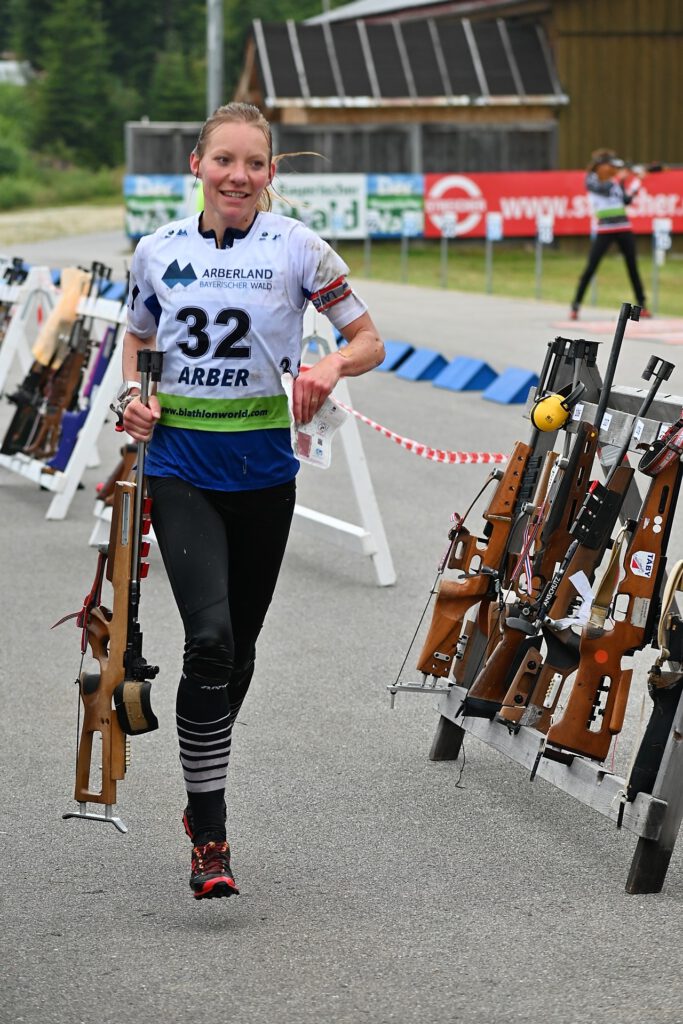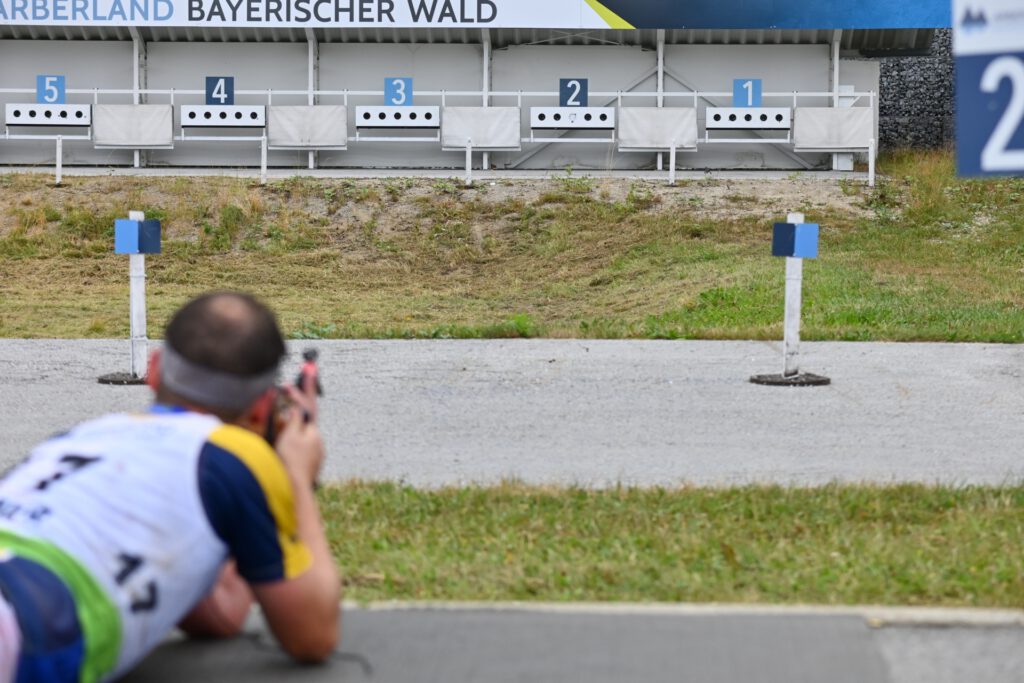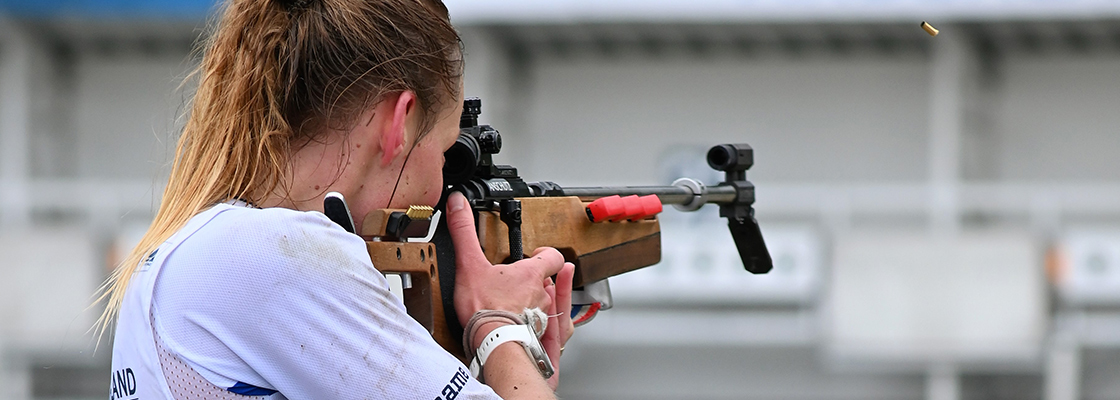Biathlon Orienteering is a combination of orienteering and shooting. The sport is very similar to biathlon, but with orienteering instead of cross-country skiing. In addition to orienteering, a cal. .22 Long Rifle weapon is used, as in biathlon, at a shooting range to shoot at self-marking biathlon targets at a distance of 50 meters – prone and standing shooting. The athletes do not carry the weapon on their back as in biathlon. The weapons are placed in weapon stands at the shooting range when the athlete is not shooting.
Biathlon Orienteering World Cup competitions in four different disciplines:
- Classic distance
- Sprint distance
- Relay
- Mass start
Classic distance

Classic distance comprises the elements
- Location orienteering, with time penalties
- Free orienteering
- Shooting, with time penalties
The total competition time is the running time added together with time penalties from the location orienteering, and time penalties from the shooting in prone and standing position.
The competition, with individual time start, begins with the location orienteering. The athlete has to follow a marked route in the terrain. The route is approximately three kilometers long and marked with plastic strips in different colours. The athlete has an orienteering map that has no marked course. Along the route ten control points will appear. The athlete must mark the spot, either located on the course or at a distance, by means of a pin prick. Each millimeter of deviation of the pinprick from the real location results in a time penalty of one minute, which are then added to the running time. At each control point the athlete can get a maximum of ten minutes time penalty. The total time penalty for the local orientation cannot exceed 100 minutes.
In location orienteering there are two kinds of controls; blue controls and yellow controls. At a blue control point the athlete has to mark the actual location with a pin through the map. There are five blue controls somewhere along the course. At a yellow control point the athlete has to mark an control object outside the course, located up to 400 meters distance. The goal is to determine the control location accurately using a control description that indicates the type of control object the athlete has to locate. The control object is marked in the terrain with an orienteering control flag. Also there, there are five yellow controls along the course. At the finish of the location orienteering, the athlete gives the map to an official, and the map with the ten pinpricks will be checked and measured.
The competition continuous with free orienteering. In the men’s class, the course is approximately 8 kilometers, and in womens’s class approximately 6,5 kilometers long. Course lengths depend on how hilly the terrain is and accessibility.
The competition goes on and the athlete arrives at the shooting range. Ten shots has to be fired in prone position, which means two series of five shots. Self marking biathlon targets are used, as in biathlon. The targets to hit are 45 millimeters in diameter. For each missed target the athlete receives a time penalty of two minutes which is added to the running time. Between prone and standing shooting, the athlete has to run a course of at least 300 meters. The course can be just a running course or could be a part of the orienteering course.
The last element in the classic distance is the standing shooting. The athlete shoots two series of five shots each in standing position. The targets to hit in standing position are 115 millimeters in diameter. For each missed target the athlete will get a time penalty of two minutes. After the last shot, the competitor puts the weapon in the weapon stand and runs to the finish line. The competitor with the shortest total time is the winner.

Sprint distance
Sprint distance comprises the elements
- Free orienteering
- Shooting, with penalty loops
In the Sprint competition, the running time for the orienteering event is approximately 18-20 minutes. Course length is appriximatelye 4 kilometers in the men’s class and 3 kilometers in the women’s class. The competitors start individually with time start and with a first orienteering lap followed of prone shooting, five shots. For each missed target the athlete has to run a penalty loop for 30-45 seconds (150-200 meters).
The competition continues with a second orienteering lap and with standing shooting, five shots. For each missed target the athlete has to run a penalty loop of 30-45 seconds (150-200 meters).
The athlete puts the weapon in the weapon stand and runs to the finish line. The athlete with the shortest running time is the winner.
Relay
Relay distance comprises, for each leg, the elements
- Free orienteering
- Shooting, with three spare rounds each time at the two shootings, and with penalty loops
The relay is a team competition, consisting of three athletes in the men’s class and two athletes in the women’s class.
The winning time for each leg, excluding time due to penalty loops, is approximately 30-40 minutes, for both men’s and women’s classes. Each leg consists of orienteering, prone shooting, orienteering, standing shooting. The course lenghts at the orienteering are approximately 6 kilometers in the men’s relay, and 4,5 kilometers in the womens’s relay. Course lengths depend on how hilly the terrain is and accessibility.
At the shooting range the athlete shoots five shots at each shooting. The first shooting in prone position and the second shooting in standing position. In Relay competitions, each competitor has three spare rounds to use if targets remain standing. The spare rounds must be hand-loaded one by one, as in biathlon. If targets still remain after shooting all eight rounds in prone or standing position, the athlete must run a penalty loop for each remaining target not hit. The penalty loop has a running time of 60-90 seconds (300-400 meters).
The team with the shortest running time is the winner.
Mass start
Mass start comprises the elements
- Free orienteering
- Shooting, with penalty loops
The Mass start competition is an individual competition where all competitors in the same class start at the same time, starting with an orienteering lap. The winning times for men end women, excluded times spent in the penalty loop, are 60-80 minutes, which means approximately 10,5 kilometers for the men and 8 kilometers for the women. Course lengths depend on how hilly the terrain is and accessibility.
On the shooting range, the athlete shoots in order prone, prone, standing, standing, divided between two to four times, depending of how the orienteering courses are set. For every missed target the athlete must run a penalty loop of 50-60 seconds (250-300 meters).
The athlete with the shortest running time is the winner.
Mass start competition is at the moment not a World Biathlon Orienteering Championships discipline, but only as a competition in Biathlon Orienteering World Cup.
… and who invented it?

The birthplace of the current version of the Biathlon Orienteering is Sweden. The International Biathlon Orienteering Federation (IBOF) was founded in 1998 and the first official competitions were held. Currently, the Biathlon Orienteering sport is relatively pronounced in the Czech Republic, Denmark, Finland, Israel, Germany, Poland, Sweden and Ukraine. New nations with competitors are constantly being added, such as Egypt and Great Britain.
World Championships and World Cup races in Europe are held annually.
Source: Swedish Multisport Federation – Biathlon Orienteering.

